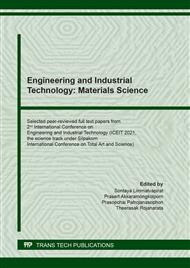p.111
p.117
p.123
p.129
p.135
p.141
p.149
p.155
p.163
Yields, Phytochemicals, and Biological Activities of Different Solvent Extracts of Senna alata Leaves
Abstract:
Senna alata leaf is used as an active ingredient in various Ayurvedic preparations due to its bioactive components. This study examined the effect of extracting solvents on total phenolic and rhein contents as well as antioxidant and anti-inflammatory capacities in S. alata leaf extracts. 95% v/v and 50% v/v ethanol (EtOH) solutions were used as extracting solvents. In spite of its lower extraction yield, 95% EtOH extract with a lower moisture content should be considered more microbiologically stable than 50% EtOH extract. As a result of the analysis using thin-layer chromatography (TLC), Fourier-transform infrared (FTIR) spectrophotometry, and high performance liquid chromatographic diode array (HPLC-DAD), phytochemicals including anthrones, coumarins, and anthraquinones were found in both extracts. Additionally, the 95% EtOH extract possessed higher phytochemical contents and biological activities than the 50% EtOH extract. Thus, the 95% v/v EtOH was a powerful extracting solvent for preparation of S. alata leaf extractscontaining high contents of phenolics and rhein, together with antioxidant and anti-inflammatory activities.
Info:
Periodical:
Pages:
135-140
Citation:
Online since:
March 2022
Keywords:
Price:
Сopyright:
© 2022 Trans Tech Publications Ltd. All Rights Reserved
Share:
Citation:


